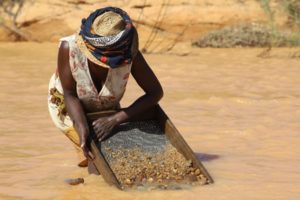Women seen as a major driving force in growth of male-dominated sector
By Tullah Stephen
“The future of Africa’s Extractive Industries (EI) is in the hands of women.” Those are the words of Ms. Simone Ellis Oluoch-Olunya, Deputy Regional Director, UN Women Eastern and Southern Africa Regional Office (Pictured).
The words at first may seem exaggerated but the truth is, the situation is quite close to that. Africa has in recent times witnessed impressive and sustained growth rates. The growth has been largely attributed to the development of the Extractive (mining, oil and gas), infrastructure, energy, transport and agricultural sectors. Africa holds 30 per cent of the world’s mineral reserves as well as large reserves of oil and gas, presenting a great opportunity for fast tracking the continent’s development and addressing perennial questions of poverty.
But for the region to fully experience sustainable benefits, there has been a growing need for players to look at the issues touching on gender diversity. “It is a well-known fact that the industry suffers from a patent lack of gender diversity. This spans from all entry level positions, all the way to the board level,” says Ms. Simone.
According to the Mining for Talent 2013 Report, by Women in Mining (UK), company profit margins are higher for mining companies when women are on their board of directors. It goes to show that investing in gender equality in this sector, makes business and economic sense for the sector. “The male dominated workplace culture in the Extractive Industries in general has often been termed as a major barrier for women, the consequences of which are translated to economic performance,” says Ms Simone
Whereas men are largely engaged in the mining itself, women are disproportionately located at the lower end of the value chain, for example, peripheral providers of goods and services such as providing lunches, washing among other activities. They are mostly part-time workers and are often relegated to secondary labor-intensive processing, with little protection against dangerous substances such as mercury.
“Women in Africa are mainly involved in artisanal and small-scale mining operations where they make up between 40 and 100 per cent of the workforce depending on the country,” she says.
Ms. Simone says the regional obstacles holding back gender equality include unequal access across the range of productive resources including land, financial resources, information about markets and appropriate technologies.
She says gender diversity has been proven as good for business. According to the Organization for Economic Co-operation and Development (OECD), countries that see the convergence of men and women in the labour force benefit from an overall increase of 12 percent in GDP over the next 15 years. Some emerging countries could see increases of 20 percent in GDP or more in the same period.

Photo: UN Women/Lyndal Lawson
“UN Women has been advocating for women to be represented across all categories of the extractive value chain, especially in decision making- positions,” Ms. Simone says.
The goal, she says, is to have women firmly located as proactive agents within the legitimate mainstream extractive sector for sustainable benefits for individuals, communities and countries. For this to happen, women need to become central actors and beneficiaries of the sector that drive Africa’s economy. “There is an opportunity to shift women from the livelihood and survival levels to true empowerment, enabling them to build assets, create wealth and move into business leadership.”
In collaboration with its partners, UN Women hosted a Regional Knowledge Sharefair on Gender in the Extractive Industries in October last year. The event provided a platform for stakeholders to discuss and consult on the key gender-specific impacts of Extractive Industries, including opportunities and solutions to barriers facing women in the sector.
It also offered an opportunity to showcase and share good practices and tools for gender-inclusive Extractive Industries, including policies, intervention and development models which can be adapted and scaled up. During the event, participants resolved to explore ways, means and practical steps to improve the legislative and policy environment for women to effectively and fully participate, contribute, and benefit from the sector.
Ms. Simone says there are opportunities for south-south learning from mature extractive countries on the continent such as Nigeria and South Africa as well as from other western countries like Australia and Canada. In South Africa for instance, mining companies were required to at least have 10 percent of women in the workforce by 2009.
“Although, the number of women at the top levels in the country is still low, extractive companies have started being more inclusive, from the ground up,” she says.
Australia, Ms. Simone further explains, has a progressive agenda to bring equity within the extractives. They provide scholarships and ensure that women and men have equal opportunities to learn and join the industry.
The other practical step the participants at the Sharefair noted was that though the African Mining Vision strategy and action plan are cognizant of gender issues, there is need to strengthen the gender component. “We need to change the mindset and look at how we operate. Once we eliminate these obstacles, we will be able to create a conducive environment for women to fully participate.”
In conclusion, Ms. Simone says “the Extractive Industries is an important driving force for economic development and promoting gender equality will unlock the growth potential for the African continent.”

